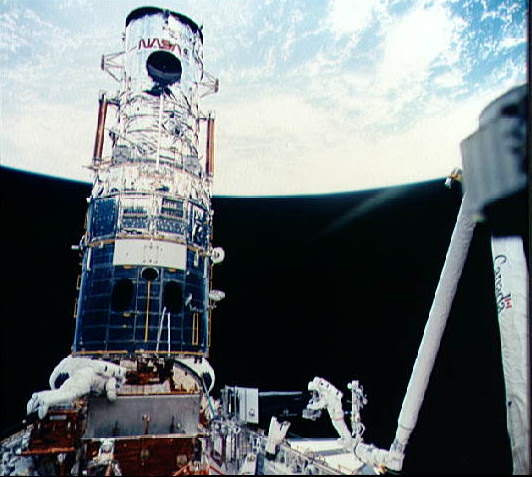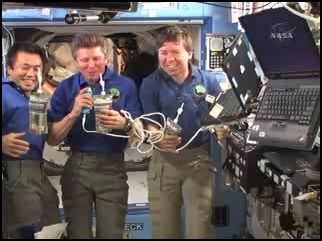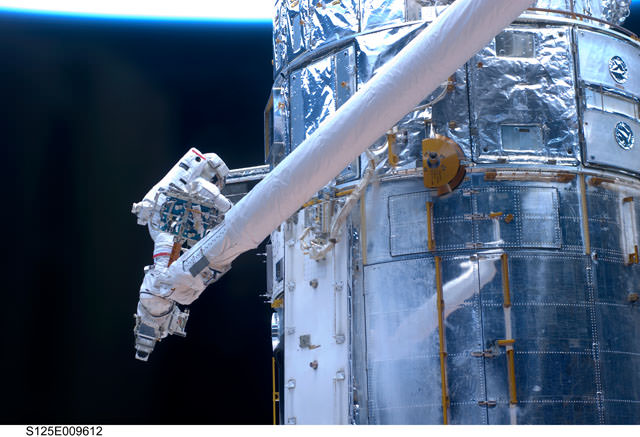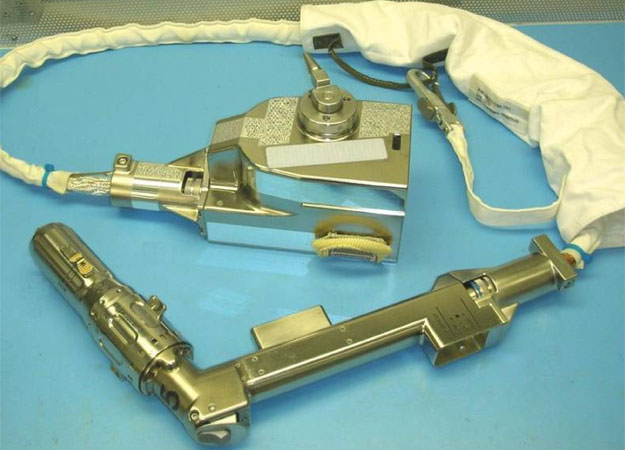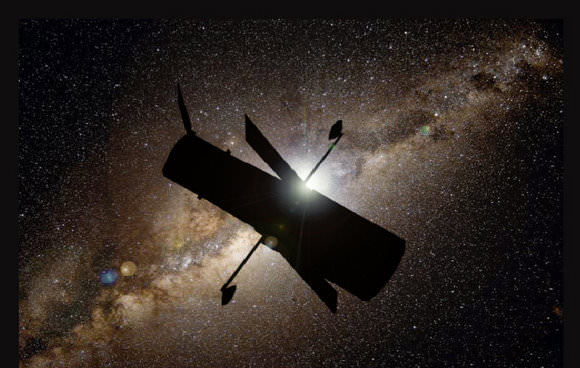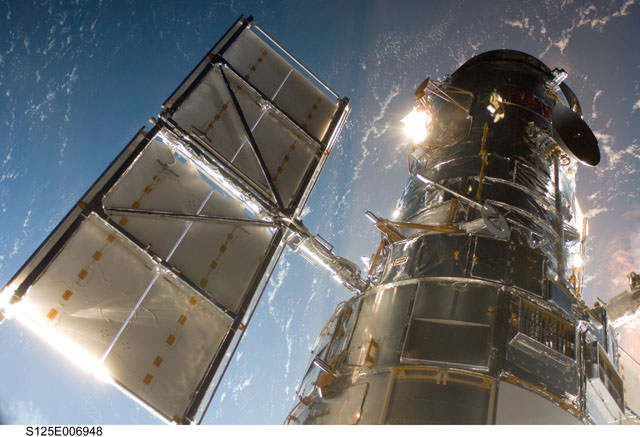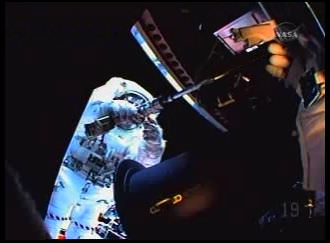
In our last installment of images from the STS-125 mission, we left off with third EVA of the mission. Since then, as I’m sure you know, the astronauts have completed two more EVAs, released Hubble and are waiting for the weather to improve in Florida so they can land. So, let’s get caught up with the latest images released by NASA. I love the image above, as it has everything in it about the mission: two spacewalking astronauts from EVA #4 (Mike Massimino and Mike Good), the shuttle Atlantis, Hubble, and a beautiful view of Earth.
Continue reading “More Stunning Images From the Hubble Servicing Mission”
A Brotherhood of Hubble Warriors: Jeff Hoffman Reflects on HST Repair Missions
[/caption]
Not surprisingly, former astronaut Jeff Hoffman has been watching the current Hubble servicing mission with interest. After all, he was a member of the first repair crew that visited the telescope in December 1993, part of the team which essentially rescued the Hubble program from what could have been a disaster. But, now Hoffman is impressed with this current crew and what they’ve accomplished, saying they are part of a “brotherhood of Hubble warriors.”
And Hoffman is feeling a little nostalgic, too.
“It certainly brought me back 15 years to when I was doing that job,” he told Universe Today. “I look at them floating around Hubble, seeing images from their helmet cameras and watching them work with all those tools, and I feel a little heart tug. But also, I feel tremendous excitement because every time we go up there we just make Hubble better and better. It’s just a phenomenal story.”
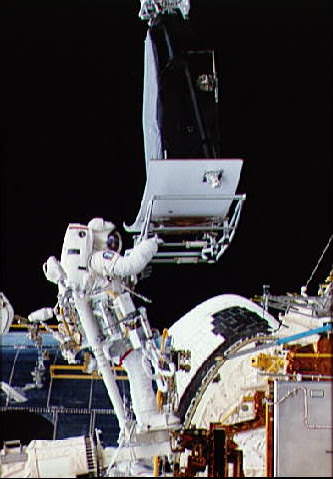
One of Hoffman’s tasks on the first Hubble repair mission, STS-61, was to install the Wide Field Planetary Camera 2. Later nicknamed “The Camera that Saved Hubble,” WFPC2 replaced the original optical camera on Hubble, and was constructed to work with the corrective optics instrument (COSTAR) – basically a set of eyeglasses to overcome the spherical aberration in Hubble’s primary mirror.
“I put the Wide Field Planetary Camera 2 in Hubble in 1993,” Hoffman reminisced, “and that is the camera that has taken the majority of the spectacular pictures by which the whole world has come to know Hubble. This crew has removed it now and replaced it with an even more powerful camera. So I had kind of a bittersweet moment when I saw “my camera” leaving the telescope!”
But he said he is looking forward to seeing even more spectacular images from WFPC3. Plus, Hoffman has been invited to Goddard Space Flight Center to see his old camera when it returns from space. “I’ll get to put my hands on it once again after fifteen years.”
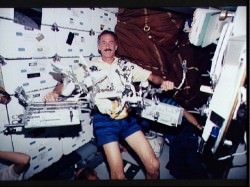
For Hoffman, what is most remarkable about the current mission was the type of work the astronauts were able to do, and the panoply of tools they had at their disposal. “One of the fantastic developments is the ability for astronauts to do complex servicing, and the tools are really what make these tasks possible,” he said. “Wearing astronaut gloves, you are really pretty clumsy. It’s like wearing welder’s gloves or ski mittens and trying to do brain surgery. But the engineers have now developed a whole suite of tools optimized for the individual tasks, allowing what would otherwise be impossible to come within the realm of what an astronaut dressed in a spacesuit can accomplish.”
The electronics on two of Hubble’s instruments had failed, — the Space Telescope Imaging Spectrograph (STIS) and the Advanced Camera for Surveys (ACS) — and the STS-125 crew basically went into the electronic guts of both instruments, pulled out circuit boards and replaced them.
Seeing the astronauts make repairs at that level was a marvel, Hoffman said. “That is something which we never imagined doing with Hubble. But it just shows how with every mission we’ve gotten more and more willing to push the envelope.”

Hoffman retired from NASA in 1997 and is now a professor of aeronautics and astronautics at MIT. He believes Hubble’s greatest legacy is how the observatory has impacted society.
“People all over the world have developed a love for Hubble,” he said, “and from Hubble we have the knowledge that the Universe is a stranger and more beautiful place that any of us had ever imagined. That’s what Hubble has done for people, giving us breathtaking images that are in some cases more beautiful than any abstract artist could come up with.”
But it’s not just the beautiful pictures. “The power of Hubble to show us what the Universe is like just one or two billion years after the Big Bang, where we can actually see the birth of the first few galaxies that were forming in our universe — this is mind boggling stuff. Hubble has re-written astronomy textbooks over the years and with the new set of instruments having even more sensitivity, it’s going to happen all over again.”
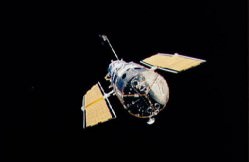
Now that the current crew has released Hubble, Hoffman recalled watching the telescope float away after the completion of his own mission. “They were probably looking at it with the same feeling of nostalgia as we did as we watched it slowly drift away,” he said. “It’s kind of a fraternity of Hubble, all the people in the six crews who have been involved with the Hubble Space Telescope. Every time I see someone from the crews that have worked on Hubble or the thousands of people on the ground who have been involved with it over the years, it’s like a brotherhood/sisterhood of Hubble warriors, so to speak. It’s been just an incredible adventure and it is nowhere near the end yet. I look forward to another 5, 10, maybe 15 years of incredible discoveries coming down from the Hubble Space Telescope.”
SRB Videos, A Toast to Recycled Urine and Other Misc. Spaceflight Notes
It has been a busy day in space and here are a few jottings about what all has been going on. Above, you can watch the spectacular videos taken by cameras mounted on the shuttle’s solid rocket boosters, taken during the launch of Atlantis on the current Hubble Servicing Mission. It’s a crazy ride, tagging along on the outside of the shuttle going up, and spinning dizzily on the way down until splashing in the ocean. Not for the faint of heart! But seeing the SRB videos means only one thing: Atlantis and the STS-125 crew have been cleared to land. NASA has carefully reviewed the videos and the data from the crew’s scan of the shuttle’s thermal protection system, saying there are absolutely no issues that would preclude the shuttle from landing. Weather, however could be another matter, which is why NASA ordered the shuttle to power down for awhile today to save on consumables. Predicted weather does not look good for landing on Friday, so the crew will make sure they have enough power to stay in orbit for a few more days.
Now about that toast…
[/caption]
A huge crowd gathered in the space station mission control room at Johnson Space Center today as the ISS crew was given a “go” to drink water that the new recycling system has purified. Everyone joined in at mission control with a toast to the success of the recycling system, giving a nod to everyone who helped create the system, install it on the ISS and work on getting the fussy system to run. This is big news, as it means the station is ready to handle the increased crew size of 6 astronauts.
Also:
The STS-125 crew held a press conference from the shuttle today. The highlight was Mike Massimino talking about how he ripped a handrail off of Hubble in order to proceed with the scheduled repair of the STIS instrument.
“Ripping that thing out of there was quite an experience, and I’m glad it led to a successful repair,” said Massimino, who added that he drew inspiration from his uncle Frank, who once ripped an oil filter out a car. “That was pretty close to what was going on with Hubble.”
Later, during a ship-to-ship call between Atlantis and the ISS, space station crew member Michael Barrett revisited Massimino’s special touch.
“The magic Massimino touch is now legendary, and we’re looking forward to seeing you guys back on the ground,” he said.
If you missed the crew news conference, its available here. Additionally, the discussion between the two crews, can be seen here.
Update: One other piece of news from the shuttle is that President Obama called the STS-125 crew to congratulate them on a job well done. “I wanted to personally tell you how proud I am of all of you and everything that you’ve accomplished,” he said.
“Like a lot of Americans, I’ve been watching with amazement the gorgeous images you’ve been sending back and the incredible repair mission you’ve been making in space,” he said. “I think you’re providing a wonderful example of the kind of dedication and commitment to exploration that represents America and the space program generally. These are traits that have always made this country strong and all of you personify them.”
Obama also said he would be naming a new NASA administrator very soon, but wouldn’t say who it is.
“Just so we’re sure, the new administrator is not any of us on the flight deck right now, is it?” asked Commander Scott Altman (Altman had suggested Hubble fix-it man John Grunsfeld for administrator earlier this week.)
“I’m not going to give you any hints,” Obama said with a laugh.
“Thank you very much, fair enough, sir,” Altman replied.
Listen to the audio and/or read the transcript of Obama’s call here.
One other spaceflight news tidbit, Orbital Sciences Corp. finally launched a Minotaur 1 rocket from the Wallops Island Flight Facility with the Tactical Satellite-3 (TacSat-3) satellite. The launch was heavily postponed, with several scrubs relating from the weather to the launch vehicle and facility. Find out more about the launch and the satellite here.
Astronauts Release Hubble — Watch the Video
After five spacewalks on consecutive days to bring new life to the Hubble Space Telescope, astronauts on space shuttle Atlantis said goodbye to the venerable observatory, releasing it back to its orbital home. Watching it float out of the cargo bay was a bittersweet moment for everyone involved with the mission, and space enthusiasts, too, as even though Hubble is in great shape and now set to look out farther than ever before, this is that last time humans will visit, touch and care for the world’s most famous telescope. “It’s a sad moment but a great moment, because we put the Hubble in the best posture and and best performance in can be in,” said Jon Morse, NASA Astrophysics division director.
Continue reading “Astronauts Release Hubble — Watch the Video”
‘Tremendous Adventure’ Gives Hubble New Life
[/caption]
Almost like Benjamin Button, the Hubble Space Telescope is now more vigorous and capable than with its original complement of instruments. “This is a tremendous adventure we’ve been on,” said astronaut John Grunsfeld at the end of Monday’s very successful EVA to repair and refurbish the famous space telescope. “This has been a very challenging mission. Hubble isn’t just a satellite, but it’s about humanity’s quest for knowledge.”
Grunsfeld and Drew Feustel installed a set of the observatory’s batteries, replaced a fine-guidance sensor that helps keep the telescope’s gaze precisely fixed on astronomical targets, and also replaced three thermal blankets protecting Hubble’s electronics.
“With today’s EVA Hubble is returned to flagship status with a full complement of instrument and tools for astronomers to use for the next several years,” saidJon Morse, Astrophyscis Division Director as NASA. “It is bittersweet to know this is our last visit to Hubble, but we have a saying in the science mission directorate: science never sleeps. So our work is just beginning. We have literally thousands of astronomers waiting to use Hubble, chomping at the bit to get their data.”
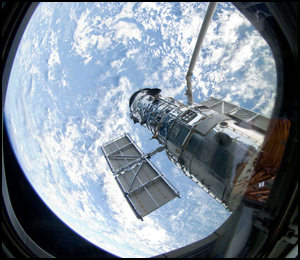
Monday’s 7 hour and 2 minute-long spacewalk marked the end of the five scheduled spacewalks for the STS-125 servicing mission. However the spacewalking team of Mike Massimino and Mike Good will be ready to go outside if any issues crop up Tuesday morning when all the systems are checked out before Hubble is released by the shuttle crew. Mission managers hope to have Atlantis back on the ground by Friday.
Earlier spacewalks overcame stubborn bolts and problematic tools, but all the mission objectives were achieved, much to the delight of everyone at NASA.
“This must be what it’s like to win the superbowl,” said Preston Burch, Hubble Program Manager. “As those of you who have followed us the past five days, working in space is challenging and there is a fine line between things that look easy and things that are impossible. The crew just never gave up.”
Lead flight director, Tony Ceccacci reminded everyone at a press conference following the EVA that Monday’s spacewalk was the last planned EVA out of the shuttle airlock. “It was both a very happy day and a sad day. We looked at each other and knew that was the last planned EVA out of the shuttle airlock. We’ve been working on this for over 2 ½ years, and we looked at each other and said, ‘wow this is really over.'”
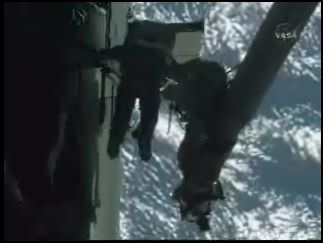
The only glitch in the otherwise smooth EVA came at the very end when Grunsfeld – a self-proclaimed “Hubble Hugger” inadvertently bumped into one of the observatory’s two low-gain antennas with his foot, breaking off a small end cap. Grunsfeld felt terrible about the accident. “OK. I’m sick,” he said. However, the antenna still worked normally, mission control radioed up to him.
Grusnfeld and Feustel placed a protective cover over the cone-shaped device for added insulation before ending the spacewalk.
“Sorry, Mr. Hubble,” Grunsfeld said as he headed back to Atlantis’ airlock. “Have a good voyage.”
“Consider it a goodbye kiss, John,” Massimino radioed from inside the shuttle.
As Grunsfeld prepared to head back inside the shuttle he asked to say a few words.
“On this mission, we tried some things that some people said were impossible,” Grunsfeld said later. “We’ve achieved that, and we wish Hubble the very best.”
A replay of highlights from the 5th spacewalk is available.
Super-Tools Essential to Hubble Mission Success
[/caption]
Astronauts from the STS-125 mission have now successfully completed all the EVAs for the Hubble Servicing Mission, accomplishing all the mission goals. Undoubtedly, the special tools the astronauts were essential to the success of the mission. In fact, at the end of today’s fifth spacewalk, astronaut John Grunsfeld called the mission “a tour de force of tools and human ingenuity.” To have any chance of completing the wide variety of tasks for this mission, NASA had to develop more than 100 new tools for removing, installing and repairing components on Hubble. “The biggest challenge for us in designing and developing tools for astronauts is to make it easy for them to use in their suit,” said Jill McGuire, manger of the CATs team (Crew Aids and Tools) for the HST mission. “EVA time is at a premium. So, any tool that we develop we develop it in order to optimize the time we have up there and make it as easy and simple for the astronauts to use.” The team built a variety of tools, from power tools to different hand tools that the astronauts used. Here’s a look at some of these super-tools:
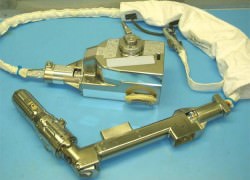
“I like all the tools, but the one I’ll probably be using the most is the Mini-Power Tool,” said STS-125 astronaut Mike Massimino before the flight. “It’s a little drill and is a unique tool that I think is going to be used in space for a long time. So, I’m very glad we’re going to be the first ones to use it and I bet you’re going to see a lot of space crews using it for many years on new space ships. This is going to be a pretty cool tool.”
NASA has long used a cordless drill called the Pistol Grip Tool, but needed a faster tool with less torque than the PGT, and Cassisdy likened the mini power tool to what Indy pit crews used to rapidly change bolts.
The mini power tool spins at 210 revolutions per minute, as opposed to the PGT’s 15.
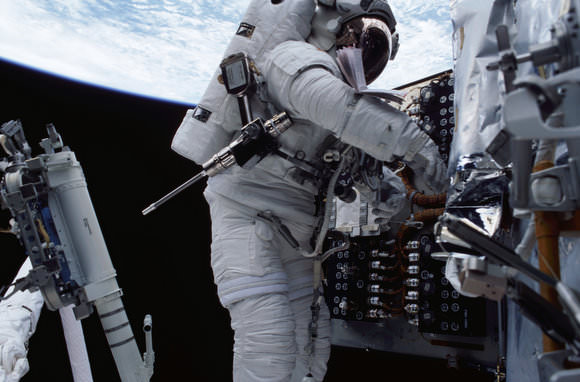
During the spacewalks, however, the astronauts did have to re-set the power tool’s torque settings to loosen some extremely tight bolts.
Some of these components, like the Space Telescope Imaging Spectrograph (STIS) were never designed for astronauts to fix on orbit. The instrument failed in 2004, and the problem was traced to the power supply. Justin Cassidy, the lead systems engineer for CATS team, compared the work astronauts would have to do on orbit to opening up a computer and replacing a board while wearing thick gloves on their hands and a fishbowl on their head.
“To actually open up an instrument and pull a board had never been thought of nor conceived that we would want to do that and therefore the interfaces were not very friendly to an astronaut,” said Cassidy.
In fact, there were 111 tiny screws that needed to be removed from the instrument in order to gain access to the board. Mike Massimino completed the STIS repair with the ingenious “fastener capture plate.”
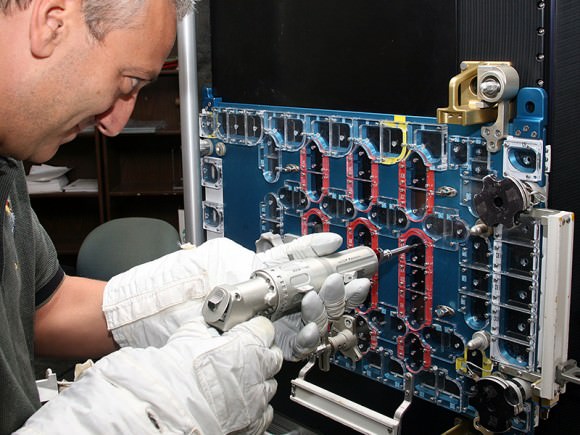
“The beauty of the fastener capture plate is, it does capture all the fasteners but it’s got a clear window,” said Cassidy. “And that clear window enables the astronaut, when he takes that power tool, he can actually see the little tiny bit going into the little tiny fastener. So, we have not blocked any of his visibility, yet when he takes that fastener out it won’t come out the little hole that the tool past through.”
It took 4-5 years to develop the mini power tool and the capture plate.
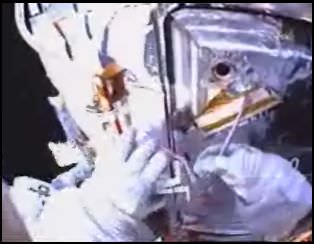
In today’s spacewalk, John Grunsfeld used a special tool to remove old insulation from the telescope so that new protective thermal insulation could be installed. The insulation protects the equipment bays on HST.
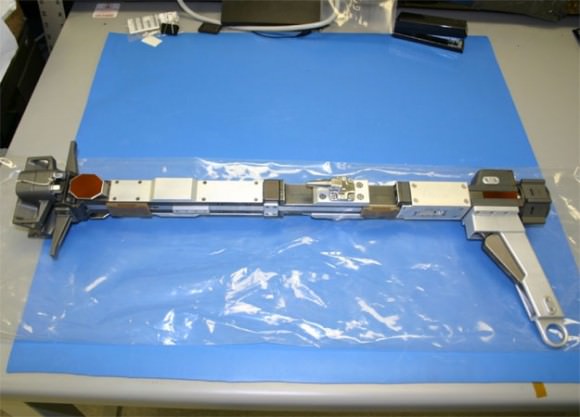
In order to replace the gyroscopes, or rate sensor units, which are located inside the Hubble Space Telescope and hard to reach while wearing a large spacesuit, engineers had to develop a tool that would work like an extension to an astronaut’s arm. Here is the Rate Sensing Units Changeout Tool, a crew member is able to reach inside the telescope without entering it, and capture and restrain a sensor unit by pulling a trigger. The tool is able to withstand temperatures ranging from -74 degrees F to 189 degrees F.
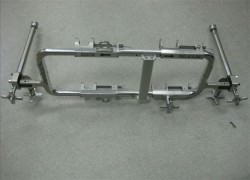
This Battery Extraction Tool allows an astronaut “grab” the batteries on Hubble, and exert additional force to remove it. This tool is capable of exerting several hundred pounds of exertion force.
“One could think you go to the hardware store and actually pick out a tool and use that in space,” said Cassidy. “The space environment is very harsh. It’s very hot, very cold, and it’s also in a vacuum and most tools, power tools for example that you pick up from Home Depot just would not survive in the environment of space.
Here are just a few things the CATs team has to consider when developing a new tool”
• The tight quarters the astronaut would have to work in with the tool.
• The brief amount of time an astronaut has to take out each fastener to release the board.
• Temperature swings of 500 degrees from the heat of direct sunlight to frigid shade. Either extreme can make the metal innards of a power tool seize up instantly.
• What would happen to each of the 111 fasteners in weightlessness.
• How much the tools weigh.
• Whether the tools can withstand the vibrations of launch.
Sources: NASA, Discovery Space,
Poetry in Space: Final Pilgrims to the Hubble Space Telescope
[/caption]
As today’s final spacewalk of the Hubble Servicing Mission begins, it seems very fitting to share a poem written by my friend Stuart Atkinson. Stuart is a poet, a blogger, a member of Unmanned Spaceflight.com (which means he is a Photoshopper extraordinaire!) and a passionate promoter of space exploration. Stuart has written many touching poems previously about the Mars rovers, the Phoenix lander, the Kepler mission and many other missions, but this verse about the final human mission to the Hubble Space Telescope is priceless. See below for “The Final Pilgrims” and check out Stu’s website Cumbrian Skies for more great poetry, images and information.
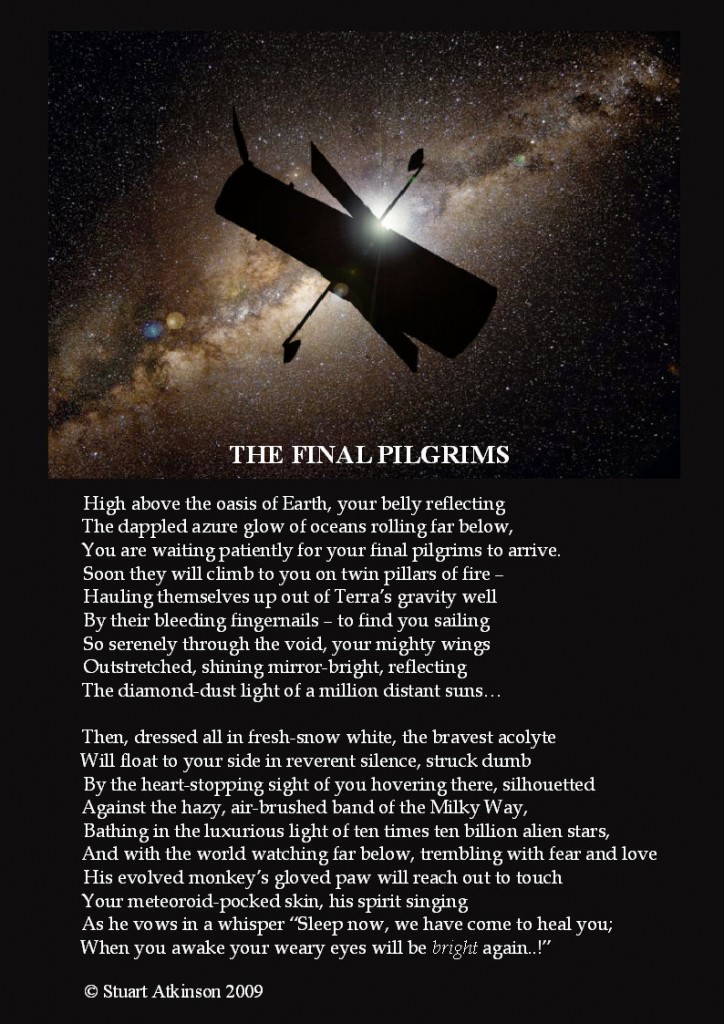
Thanks, Stu, for sharing your poem with Universe Today!
Hubble Servicing Mission 4 in Pictures, Part 1
[/caption]
The long-awaited Servicing Mission 4 for the Hubble Space Telescope has provided drama, nail-biting excitement, fist-pumping triumphs and ‘what else could go wrong now’ moments. But the best way to to describe the mission is to let the amazing images from the EVAs do the talking. Below are high-resolution images from NASA, highlighting the first three spacewalks.

The mission began with the picture-perfect, no-delay, long-awaited launch on May 11, 2009.
EVA #1

The first spacewalk of the mission, performed by astronauts John Grunsfeld and Drew Feustel lasted a little over 7 1/2 hours. They successfully installed the new Wide Field Camera 3 science instrument and a new Science Instrument Command and Data Handling Unit. Both WFC-3 and the SI C&DH passed their “aliveness” tests, which essentially means the devices powered on correctly. The WFC-3 also passed its functional test, meaning the capabilities of the instrument itself were tested. The SI C&DH unit has also received an initial OK on its functional test, pending final review of data sent down to the ground.
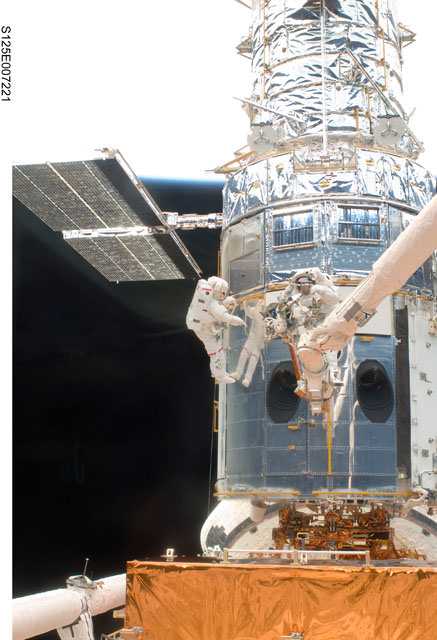
A stubborn bolt threatened to thwart one of the spacewalk’s main goals, replacing the venerable space telescope’s workhorse optical camera with a new and improved instrument. But after a fair amount of old fashioned elbow grease, the WFPC2 was able to be removed.

This close-up of Grunsfeld was taken by Drew Feustel, whose reflection is visible in Grunsfeld’s visor. Feustel is attached to the end of the shuttle Remote Manipulator System, or robotic arm. Grunsfeld was the free-floating astronaut for the EVA.

Here, Feustel, on the end of the shuttle’s robotic arm, carries the piano-sized WFPC3 to its new home inside Hubble.
EVA #2

The second EVA of the mission provided some challenges to astronauts Michael Good and Mike Massimino. However, they achieved all the objectives for this spacewalk, it just took them awhile — 7 hours and 56 minutes. They installed three Rate Sensor Units (RSUs), with a pair of gyros in each, and the first of two new battery module units.

Good and Massimino were not able to get one of the three prime RSUs into its slot but were able to install a spare, giving Hubble the new gyros it needed. The gyros are used to change the orientation of the telescope and keep it fixed on a particular astronomical target during observations.

The spacewalkers also removed one of the original battery modules from Bay 2 of the telescope and replaced it with a new unit. The batteries provide power to the telescope when Hubble passes into Earth’s shadow and its solar arrays are not exposed to the sun. Ground controllers at Goddard’s Space Telescope Operations Control Center confirmed that all six gyroscopes and the new battery passed preliminary tests.
EVA #3

The third EVA of the mission went like clockwork as Grunsfeld and Feustel teamed up again. They removed the Corrective Optics Space Telescope Axial Replacement and installed in its place the new Cosmic Origins Spectrograph. They also completed an unprecedented repair of the Advanced Camera for Surveys replacing an electronic card and installed a new electronics box and cable.

To do the repairs on ACS, Grunsfeld removed 32 screws from an access panel to replace the camera’s four circuit boards and install a new power supply. The two astronauts used specially designed tools to do a job that was never intended to be done on orbit. But they did it, and with efficiency.
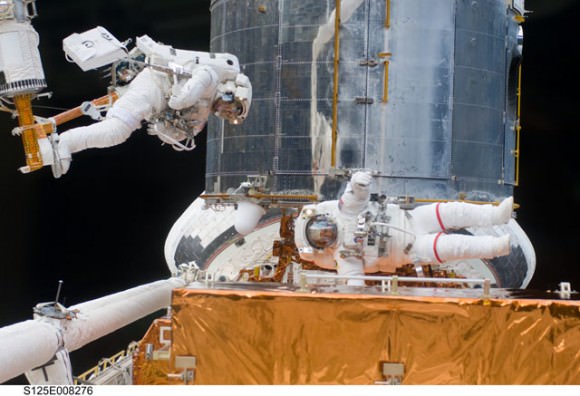
Engineers at Goddard have already performed “aliveness” tests on both COS and ACS to verify they have electrical power. However while a functional test of the ACS indicated success in reviving the instrument’s heavily used wide-field channel, officials said early Sunday that it appears the repairs failed to resolve power problem with the camera’s stricken high-resolution channel and it appears “down for the count.”
We’ll keep you posted on any developments with ACS, and provide more high-resolution images from the remainder of the mission soon!
For more images from the mission, or to download higher resolution versions of the pictures here, visit NASA’s Human Spaceflight gallery.
Marathon EVA for Hubble Astronauts
[/caption]
The Hubble Space Telescope kept throwing curveballs at spacewalking astronauts on Friday, but with more elbow grease and a “if at first you don’t succeed, try again” attitude they were able to accomplish all the objectives for the second EVA of the repair mission. In what turned out to be the 8th longest spacewalk in US history, Mike Massimino and Mike Good replaced six gyroscopes – two wouldn’t fit, so spares had to be used — and four batteries. Both jobs were top priorities for the mission, and will give Hubble the power and control it needs to keep going until at least 2014, hopefully longer.
To start off the spacewalk, there were some tense moments when Massimino’s communication system didn’t work, and for about two minutes no one could hear him. “That was a little scary,” Good said after communication was reestablished.
Replacing the gyroscopes was the first task, and a big requirement for the mission. Three of the old gyroscopes no longer worked, and two others had been having problems recently.
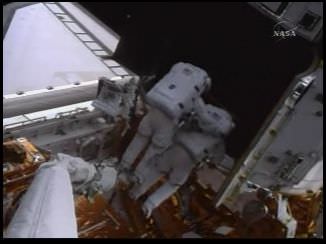
Massmino, who is over 6 feet tall, squeezed inside Hubble to begin removing the old gyros. “Trained my whole life for this,” he said.
The old gyroscopes came out with no problems, but two of the new ones didn’t “seat” correctly and couldn’t be bolted in. Two spares were retrieved and installed, but by the time the gyroscope task was completed, five hours had ticked by on the spacewalk. At one point later on in the EVA, the astronauts “plugged in” to get more oxygen to make sure they had enough for the rest of the lengthy excursion outside the shuttle.
The support crew inside the shuttle tried to keep things light to encourage the two spacewalkers. “My friend Leonidas has a couple of words for you guys that are appropriate right now,” shuttle commander Scott Altman told the spacewalkers, referring to the ancient Spartan king. “Remember this day, men, for it will be yours for all time.”
“We’ve got a little more work to do, but thanks,” Massimino replied.
Next on the agenda was replacing the huge batteries, which weigh over 500 lbs each. As the spacewalkers successfully finished that task, astronaut John Grunsfeld radioed, “Great job guys. Batteries ARE included on this flight!”
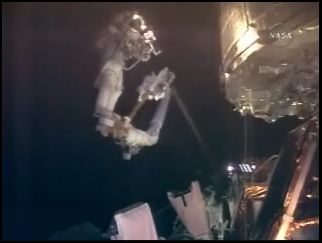
Three more batteries will be replaced in an EVA next week.
The spacewalk ended after 7 hours and 56 minutes, surpassing another spacewalk back in 1993 to replace gyroscopes on Hubble.
“Every day has been ‘hold your breathe’ on this mission,” said Dave Leckrone, HST Senior Scientist at a press briefing following the EVA. “That points to the complexity of the observatory and what it takes to maintain it.”
On Saturday, the third spacewalk of the mission will replace the Cosmic Origins Spectrograph, and repair the Advanced Camera for Surveys. This will be the first time a repair — and mot just a replacement — of a Hubble instrument in space will be attempted.
Amazing Images of Shuttle and Hubble Transiting Sun
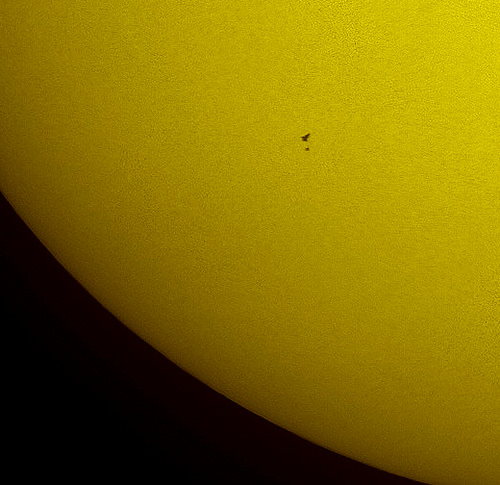
[/caption]
No, these aren’t sunspots finally appearing on our currently quiet sun. Check out these amazing images taken by photographer Thierry Legault. The “spots” are actually the space shuttle Atlantis and the Hubble Space Telescope transiting across the sun! Legault’s website says these are the only images ever taken of a transit of a shuttle and the HST in front of the Sun. Legault was in Florida at the time he took this image, about 100 km south of the Kennedy Space Center on May 13th 2009 12:17 local time, several minutes before grapple of Hubble by Atlantis. The transit only lasted .8 seconds, and Legault was able to snap 4 images a second, getting a total of 16 different shots of the entire event (he started shooting 2 seconds before the predicted transit.)
He took another image the previous day of just the shuttle transiting (see below.)
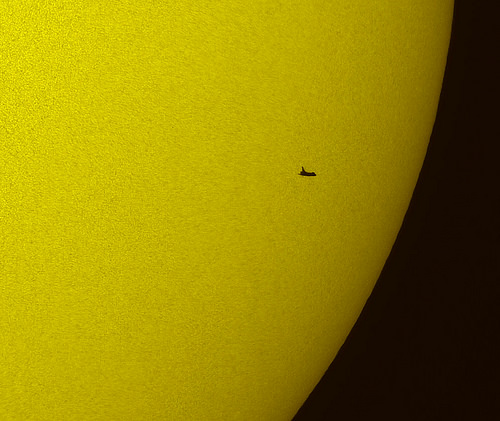
Here, space shuttle Atlantis is seen in silhouette during solar transit, on Tuesday, May 12, 2009, also taken from Florida. This image was taken made before Atlantis and the crew of STS-125 had caught up with the Hubble Space Telescope.
Amazing!

